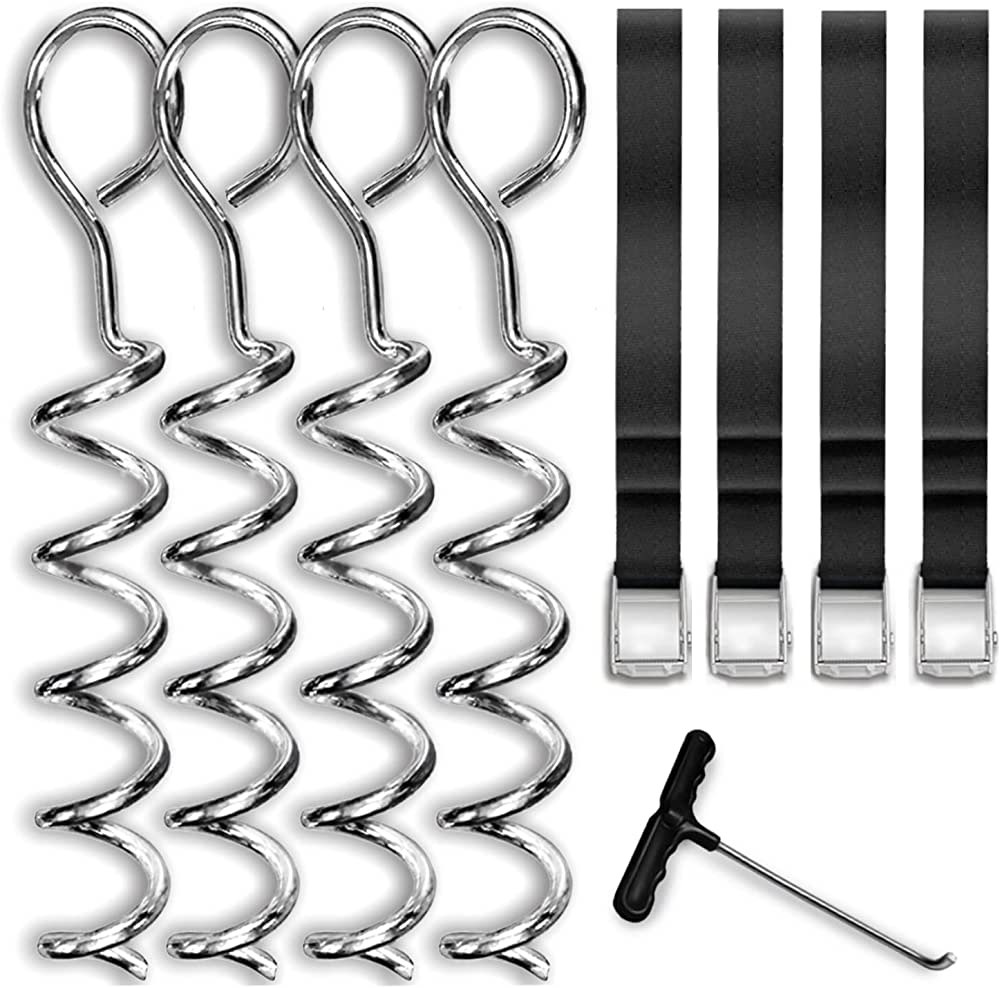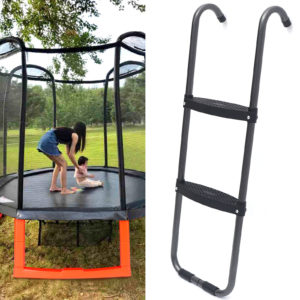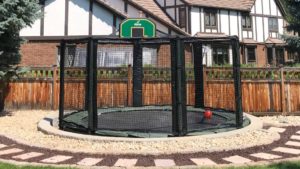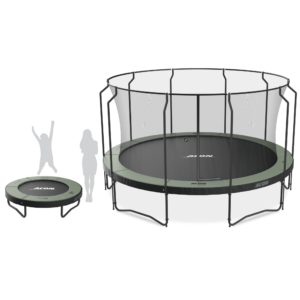Trampoline stakes are metal or plastic anchors used to secure a trampoline to the ground. They are typically used to prevent the trampoline from tipping over or moving during use, especially in areas with high winds or uneven ground.
Trampoline stakes can be purchased separately from the trampoline or may come included with certain trampoline models. Using trampoline stakes can help improve the safety and stability of a trampoline, and is recommended by many manufacturers and safety organizations.
Can you stake a trampoline?
Yes, you can stake a trampoline to help prevent it from tipping over or being blown away during strong winds. Trampoline stakes are specially designed to be driven into the ground and then attached to the legs of the trampoline to help anchor it in place.
However, it’s important to use the correct type of stakes and ensure they are installed properly to provide adequate support and stability for the trampoline. Some trampolines come with stakes included, while others require you to purchase them separately. It’s also a good idea to check your trampoline manufacturer’s instructions for recommendations on staking and anchoring.
Do trampoline wind stakes work?
Yes, trampoline wind stakes can be an effective way to secure a trampoline to the ground and prevent it from tipping over or moving during high winds. Trampoline wind stakes work by anchoring the trampoline legs to the ground using metal or plastic stakes that are driven into the soil or turf. The stakes create a strong and stable foundation that can help prevent the trampoline from being blown away or displaced during strong winds.
However, it’s important to note that the effectiveness of trampoline wind stakes can depend on various factors, such as the strength and direction of the wind, the weight and size of the trampoline, and the type of soil or turf it is anchored in. Additionally, using trampoline wind stakes does not guarantee complete safety, and it’s still important to follow proper safety guidelines and precautions when using a trampoline.
Overall, using trampoline wind stakes can be a helpful safety measure, but it’s important to use them properly and in conjunction with other safety features such as safety nets, padding, and supervision.
Why is it important to tie down a trampoline?
It is important to tie down a trampoline to prevent it from being blown away in high winds. Trampolines can become dangerous projectiles in strong winds, and can cause damage to property, people, and vehicles. By tying down a trampoline, you can help prevent it from being blown away, and reduce the risk of accidents and injuries.
Tying down a trampoline can also help prevent it from shifting or tipping over during use. This is especially important for larger trampolines or those that are set up on uneven ground. A securely anchored trampoline will be more stable and less likely to cause injuries or accidents.
Additionally, many insurance companies require that trampolines be securely anchored as a condition of coverage. So, by tying down your trampoline, you may be fulfilling a requirement of your insurance policy and ensuring that you are covered in case of accidents or damage.
What is the best way to stake a trampoline?
The best way to stake a trampoline will depend on the specific model and the type of ground or surface it will be anchored in. Here are some general tips to consider when staking a trampoline:
- Choose the right type of stakes: There are various types of trampoline stakes available, including metal or plastic auger-style stakes, U-shaped stakes, and spiral stakes. Choose a type that is suitable for the type of ground you will be staking the trampoline in.
- Position the trampoline: Before staking the trampoline, make sure it is in the desired location and properly leveled. This will help ensure that the trampoline remains stable and safe.
- Attach the stakes: Once the trampoline is in position, attach the stakes to the legs of the trampoline. Make sure they are securely fastened and angled away from the trampoline.
- Drive the stakes into the ground: Use a mallet or hammer to drive the stakes into the ground at a slight angle, making sure they are firmly anchored. Avoid hammering the stakes straight down, as this can cause them to bend or become dislodged.
- Test the stability: After staking the trampoline, test its stability by pushing on the frame from different angles. If the trampoline moves or wobbles, adjust the stakes or reposition the trampoline as needed.
Overall, it’s important to follow the manufacturer’s instructions and recommendations for staking your specific trampoline model, as well as any local safety regulations or guidelines. Properly staking a trampoline can help improve its stability and safety, reducing the risk of accidents or injuries during use.
How do I keep my trampoline from blowing away?
Here are some ways to help prevent your trampoline from blowing away:
- Use wind stakes: As mentioned earlier, using wind stakes can be an effective way to anchor your trampoline to the ground and prevent it from being blown away during strong winds. Make sure to use the right type of stakes for your trampoline and ground type, and position them at a slight angle away from the trampoline.
- Store the trampoline during severe weather: If you know a storm or severe weather is coming, consider disassembling the trampoline and storing it indoors or in a garage until the weather passes. This can help protect the trampoline and prevent it from being damaged or blown away.
- Choose a sheltered location: When setting up your trampoline, choose a location that is sheltered from strong winds and gusts. Avoid placing it in open, exposed areas or on high ground.
- Add weight to the trampoline: Adding weight to the base of the trampoline can help improve its stability and prevent it from tipping over or being blown away. You can use sandbags, cinder blocks, or other heavy objects to weigh down the base of the trampoline.
- Monitor weather conditions: Keep an eye on weather forecasts and be prepared to take action if severe weather is expected. If high winds or gusts are forecasted, consider temporarily disassembling or securing the trampoline until the weather passes.
Overall, it’s important to prioritize safety and take necessary precautions to prevent accidents or injuries related to trampolines, especially during severe weather conditions.
Should I stake down a trampoline?
Yes, it’s generally recommended to stake down a trampoline to help ensure its stability and prevent it from tipping over or being blown away during strong winds. This is especially important if you live in an area that experiences frequent high winds or severe weather conditions. Trampoline stakes are designed to be driven into the ground and then attached to the legs of the trampoline to help anchor it in place.
It’s important to use the correct type of stakes and ensure they are installed properly to provide adequate support and stability for the trampoline. Additionally, it’s important to regularly check the stakes to make sure they are secure and tight.
At what wind speed do trampolines fly away?
The wind speed at which trampolines can fly away depends on various factors, such as the size and weight of the trampoline, the height it is set off the ground, the number of people using it, and the wind conditions.
However, generally, trampolines can become dangerous and fly away in winds over 35-45 miles per hour (56-72 km/h) or during severe weather conditions such as hurricanes or tornadoes.
Therefore, it’s important to always monitor the weather conditions and take appropriate precautions, such as staking down the trampoline, when high winds or severe weather is expected.
How do you reinforce a trampoline in the ground?
To reinforce a trampoline that is set in the ground, there are a few steps you can take:
- Use quality materials: Use high-quality materials such as treated wood, concrete, or bricks to construct the retaining wall that will support the trampoline. This will ensure that the trampoline is supported and will last longer.
- Ensure the ground is level: Before installing the trampoline, make sure the ground is level to ensure that the trampoline is stable and secure.
- Install a retaining wall: A retaining wall will help to support the weight of the trampoline and prevent the surrounding soil from collapsing or shifting. Make sure the retaining wall is securely installed and reinforced with concrete or mortar.
- Anchor the trampoline: Use trampoline stakes or concrete anchors to anchor the trampoline to the ground. This will help to prevent the trampoline from being blown away in high winds.
- Regular maintenance: Regularly inspect the trampoline and its components, such as the retaining wall and anchoring, to ensure that they are in good condition and secure. Make any necessary repairs or replacements promptly.
By taking these steps, you can reinforce a trampoline in the ground and help ensure its safety and longevity.
What is pros and cons of trampoline stakes?
Pros of Trampoline Stakes:
- Improved stability: Trampoline stakes help to keep the trampoline firmly in place, providing a more stable and safe jumping experience.
- Safety: Staking down the trampoline can help to prevent it from tipping over or shifting during use, which can reduce the risk of accidents and injuries.
- Wind protection: Trampoline stakes can help to prevent the trampoline from being blown away in high winds, which can be dangerous and cause damage to property or people.
Cons of Trampoline Stakes:
- Installation: Installing trampoline stakes can be time-consuming and may require some additional tools or equipment.
- Aesthetics: Trampoline stakes may not be aesthetically pleasing and may detract from the appearance of your yard or outdoor space.
- Potential damage: Driving stakes into the ground can potentially damage underground utilities or irrigation systems if not installed properly.
Overall, trampoline stakes can be a great investment for improving the stability and safety of your trampoline, especially in windy areas. However, they may require some effort to install and may not be the most visually appealing option. It’s important to choose high-quality stakes and follow the manufacturer’s instructions for installation to ensure that they are effective and do not cause any damage.
Can you leave a trampoline up all year?
While it is possible to leave a trampoline up all year, it is generally not recommended. Trampolines that are left up year-round are exposed to the elements and can become damaged or worn out more quickly than those that are taken down and stored during the off-season.
Exposure to the sun, wind, rain, and snow can cause the trampoline mat, springs, and frame to deteriorate over time. This can lead to weakening of the structure and potential safety hazards for users. Additionally, leaves, debris, and other materials can accumulate on the trampoline and make it less safe and less enjoyable to use.
To ensure the longevity and safety of your trampoline, it is recommended to take it down and store it during the off-season or times when it will not be used for an extended period. This will help to protect the trampoline from damage, keep it clean and safe, and extend its lifespan.
You May Also Like These Deals!
What is trampoline ladder used for?
A trampoline ladder is an accessory designed to provide easier...
Read MoreWhat is in ground trampoline used for?
An in-ground trampoline is a type of trampoline that is...
Read MoreHow to Choose the Correct Trampoline Size
Which trampoline size is ideal for your family and backyard?...
Read MoreBest Black Friday Trampoline Deals
This year, are you looking for a trampoline? There are...
Read MoreProducts recommended in the post contain affiliate links. We may receive a commission when you buy something through our posts.
Why Trust Us
You will find what you are looking for at Black Friday Weeks. From classic to luxury brands, you'll find both. We will help you to select appliances that fit your needs, budget and lifestyle. Whether you want to stop by to learn more — or plan to make a major purchase — we’ll treat you like family and assist you every step of the way. Shop with us today to receive friendly and experienced help along the way.





